Shipping pallets facilitates the logistics operations of a warehouse or distribution center. If you want to choose the best-suited pallet for your transportation, you need to know:
What are pallets used for?
A pallet is a flat platform used for stacking, storing, and transporting goods. It can be stored on shelves or in transport vehicles. Typically, a pallet consists of decks and two or four supporting beams called stringers or blocks. These features allow for easy lifting and movement when using forklifts, pallet jacks, and other handling equipment.
Pallets are the most common unit of loading and often follow standardized size measurements. They support using various types of straps and bindings to secure goods or bundle other pallets together. Also, they are compatible with a variety of handling equipment, facilitating efficient stacking, loading, and transportation.
Pallets provide a stable base for securing and protecting goods during transit, reducing the risk of tilting or collapsing. And they also offer cushioning to prevent damage to products. Their presence increases the likelihood of items reaching their destination safely.
Moreover, pallets can get nested together like puzzle pieces to enhance cubic space utilization. They are adaptable to various modes of transportation, including trucks, trains, and airplanes. This versatility enables seamless multimodal transportation and logistics coordination.
There are different kinds of pallets, depending on size, composition, etc. We list below the main existing pallets and their characteristics.
Pallet types based on materials
The material selection for pallets is quite diverse. And different materials have their own characteristics and suitable scenarios. Here are some common choices of pallet materials.
Wooden pallets

Wooden pallets make up 90-95% of the market and remain in high demand for numerous reasons. It feature strength, durability, and cost-effectiveness. They are easy to process and can get easily customized into various sizes as needed. Additionally, they are recyclable, quickly repaired, and environmentally friendly.
It’s important to be aware that in some countries, the use of wooden pallets may require compliance with ISPM 15, which mandates fumigation treatment for wooden pallets.
Plastic pallets
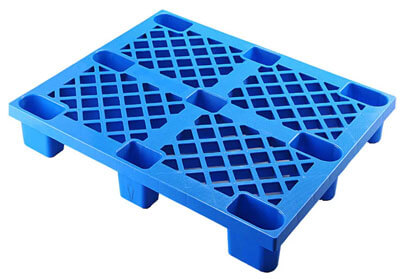
Plastic pallets are lightweight, durable, and easy to clean. Most of them can get recycled for reuse. In addition, they are waterproof and resistant to bacterial contamination, making them an ideal choice for shipping food, paper, pharmaceuticals, and cement. They also offer better protection against damage if they are knocked over.
However, they are prone to deformation and come with an additional cost. Repairs are not feasible for plastic pallets.
Metal pallets
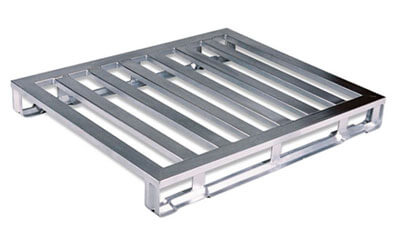
Metal pallets come in various types such as aluminum and stainless steel, offering extremely high strength and durability. They can withstand heavy loads. So they are mainly used for transporting heavy industrial components. Additionally, metal pallets are easy to clean and disinfect, but their cost is higher compared to other types of pallets.
Paper pallets
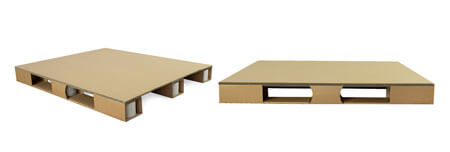
Paper pallets, also called corrugated pallets, are made from cardboard or reinforced paper. They are lightweight, easy to handle, and can be customized. The manufacturing process of paper pallets is simple, so they are cost-effective. And they can be recycled after use. Due to their lower strength, they are suitable for transporting light products. However, paper pallets are prone to deformation.
Various pallets based on styles
Pallets can be classified into different styles. Support, number of entry points, deck configurations, and features and design of the pallet are some aspects that you should consider when choosing a pallet.
Stringer pallets
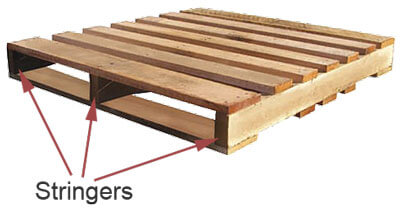
Source: Conner Industries
As the most common type, it has three or more long boards running along their length, which are called “stringers.” They are strong and can carry heavy loads, so they are often used for tough and heavy jobs. Due to its simple structure, it is very easy to manufacture and maintain.
Block pallets
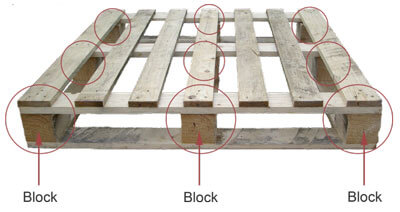
Source: Conner Industries
Block pallets are supported with 9 columnar posts called blocks. They are at the four corners, the center of each side, and the middle of the pallet. These blocks provide enhanced stability and support, making them suitable for heavy loads and racking systems. Block pallets have four entry points, allowing forklifts or other handling equipment to enter from any one of them.
Four-way pallets
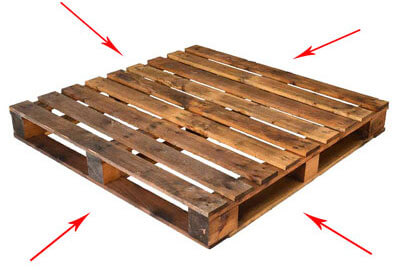
A four-way pallet has four entry points, hence it is also referred to as a full-rotation pallet. They are typically made up of longitudinal and transverse boards. They allow forklifts or other handling equipment to enter from any direction, resulting in the highest handling efficiency. And it is also very convenient for nesting and stacking. This pallet is the most durable type of pallet, with the highest weight-bearing capacity, but they are also the heaviest and most expensive.
Two-way pallets
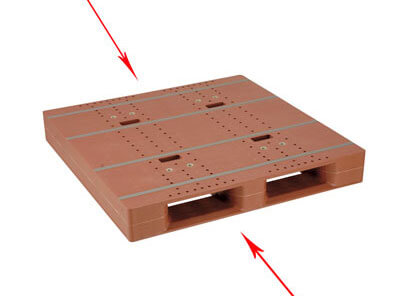
This type of pallet has two entrances, allowing entry from only two sides. Due to the limited entry points, mechanical equipment is required to manipulate it at specific angles, or the pallet must be stored in a specific orientation. The structure of the two-way pallet is relatively simple. It is more suitable for applications where frequent directional changes are not necessary during loading and unloading. And it is more cost-effective compared to the four-way pallet.
Different pallets based on sizes
The standardization of pallet dimensions eliminates difficulties in handling materials for various equipment and vehicles, making global trade easier. Different regions have different organizations and associations to regulate the sizes of transport pallets. Some commonly used ones are as follows.
ISO standard pallet sizes
ISO has established several globally recognized pallet standards, such as ISO 6780. It specifies the dimensions, design, and performance requirements for pallets, facilitating the efficient management of global logistics and supply chains. ISO standard dimensions include 1200 mm × 1000 mm, 1200 mm × 800 mm, 1100 mm × 1100 mm, etc.
These dimensions can accommodate various types of goods, storage, and transportation needs, making them applicable on a global scale.
GMA Pallet Sizes
It is a standard size established by the Grocery Manufacturers’ Association (GMA), applicable in the North American region. The most common size is 48 inches × 40 inches. And you can find some counterparts of GMA pallet sizes in the ISO standard, such as 1,067mm × 1,067mm (42 inches × 42 inches). GMA standard tailor fits pallet sizes to industry-specific needs.
Euro Size Pallets
This is a widely used standard size in the European region, established by European countries and industries themselves. The most common size is 1200mm × 800mm, which is the same as one of ISO’s standard sizes. These pallets are designed to optimize storage space and can be compatible with European handling equipment. This standard is suitable for most goods and warehouse systems in Europe.
What should you consider when choosing pallets for your shipping?
When choosing pallets for shipping, there are several important factors to consider to ensure the safe and efficient transportation of your goods. Here are some key considerations:
Types of goods
Different types of pallets are suitable for different kinds of products. So you need to consider the nature, size, weight, and fragility of the goods. For instance, heavy-duty items might require sturdier pallets like metal pallets. And fragile goods might need pallets that can provide cushioning, such as paper or wooden pallets commonly used for shipping ceramic tableware.
Sizes and designs
You should select the appropriate size and consider the number of entry points. Also, you need to consider the pallet design such as beam-type or block-type structure, to align with the dimensions of the goods and the storage and handling equipment. It helps achieve efficient loading and stacking. Generally, freight forwarders will choose the most suitable pallets for transportation based on your budget and requirements.
As a leading sourcing company in China, JingSourcing has helped 4000+ clients buy and customize products from Chinese factories. We also have cooperated with many freight forwarders who are experienced in pallet shipping and container shipping. So we can provide you with flexible shipping solutions to your designated places.
